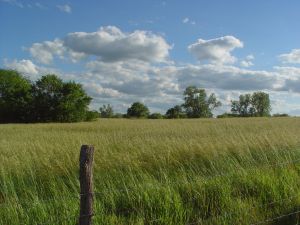Louisville, Ky. When Wendell Berry and Wes Jackson took a proposal called The 50-Year Farm Bill to Washington almost two years ago, they had no illusions that they were going to get a Senate sponsor out of the trip or hear some of their suggestions immediately proposed for Congressional debate.
What they did hope was to start a conversation, here and there all over the country—conversation that might lead us to solve the nagging problem of how to feed both ourselves and the multi-billions of people worldwide our future is likely to hold, and away from wranglings over farm subsidies to Manhattanites and the food stamp program (now called SNAP, and whose funding takes up the wolf’s share of the federal Farm Bill allottment).
Those two items deserve some discussion, granted. But we would do well to remember that if we take every subsidy cent away from nonfarmers, and finance the Supplemental Nutrition Assistance Program to the level of its proponents’ fondest hope, none of that will matter if we can’t grow enough food to feed ourselves.
It is food production—also known as “farming”–and land use that are the core issues in any debate about food itself, be it local or international, slow or fast. Yet so often discussions of food-and-farming devolve into discussions of food-only–and often into debates about gourmandism, which is a very nice job, when you can get it. I like a good meal myself. But before Julia Child could lift a pan off her kitchen pegboard, or Marcella Hazan raise her rolling pin above a lump of pasta dough, somebody had to grow the raw materials. And while tonight’s roast chicken is soon to be a happy memory, tomorrow’s need for yet another dinner looms apace.
Do your eyes glaze over at any discussion of farming? (Ah, dear readers, I have seen some of you yawning.) In that case do as Dr. Jackson cheerfully suggests, and think of the 50-Year Farm Bill as a 50-Year Eating Bill. Because I feel sure you like to eat. And without the one you cannot do the other.
Here is the plan in a nutshell: The 50-Year Farm Bill proposes the government set aside $50 million annually for eight years to sponsor 80 plant breeders and geneticists to develop perennial grain, legume and oilseed crops, plus 30 agricutural and ecological scientists to develop the needed agronomic systems. (I should say here that Dr. Jackson and his co-author Fred Kirschenmann of the Leopold Center do not want money for their own organizations. The Land Institute will offer its germplasm to other researchers for free.)
Why perennial? To keep our land farmable. Wes Jackson likes to say that farming is akin to mining, and that we’ve been living for thousands of years off the energy formerly locked in our soils. Now the seam is running out. In an effort to marry farm practices to sustainable soil use, the Land Institute has been working for thirty years to develop perennial crops that can be grown in fields of mixed species, closely paralleling the way plants grow in nature—closely mimicking the great prairie, actually. It’s no accident the Land Institute is in Kansas.
Researchers there have concentrated on grains, legumes and oilseeds because about 2/3 of our calories come from them. Man does not live by bread alone, but he does eat an awful lot of it.
Is perennialization possible? Dr. Jackson thinks so. He says his group is about eight years from being ready to send out seeds of a perennial wheat relative–an intermediate wheatgrass called Kernza™. (Once in a while you can get a sample.) Other crops in the works include a perennial grain sorghum, a soybean substitute called Illinois bundleflower, sunflower, and rice.
But there is no quick turnaround for this enormous project. While Dr. Jackson and his colleagues hope to have the wheat substitute in less than a decade, he expects the other crops will require 25 years to develop. In the 50-Year Farm Bill, the rollout for those other perennials is 2044. He and Mr. Berry, for two, will not live to see it.
I’ll ask it again: Is perennialization possible? I don’t know myself. In a world with so much hunger, and with so much human pressure on our arable land, it seems worthwhile finding out—and to start by having a conversation about it, among land grant universities, farm and environmental organizations, and within our political parties, too. There isn’t much of a farm constituency anymore; it’s limited to a few states and a remarkably small number of counties nationwide. But as Mr. Berry and Dr. Jackson have pointed out, every voter has to eat.





10 comments
naa
Does anyone know how to reach Kate Dalton by email? There is Louisville info. available that my interest her.
Katherine Dalton
To Michael: Your concerns are common ones and logical. But the jury is still out on yields from perennial wheatgrass, because we don’t have seed ready for wide testing yet. Dr. Jackson addresses your views at the end of the 50-Year Farm Bill on his site, linked above, and says that perennials’ ability to use solar energy and water year-round may mean they can be more and not less productive than annuals. Breeding for perennial *seed* (rather than stalk, etc.) will also have a large effect. He adds that while we are unlikely to match the largest annual crop wheat yields, those top numbers were achieved by depleting soils, and he is much more sanguine about matching more sustainable yields. See the link if you’re interested.
To Stewart: Sounds great and good luck.
Thanks to Mr. Sabin for a good additional plantsman’s observation.
Thanks also to the Confucian for an explicit reference to the book slightly referenced in my article title. It is dusty, isn’t it? But it shouldn’t be.
The Western Confucian
Perhaps it’s time to dust off Franklin Hiram King‘s tome, this year celebrating its centennial — Farmers of Forty Centuries; Or, Permanent Agriculture in China, Korea, and Japan.
Cecelia
while the debate on yields is important – the benefits of soil retention are likely to outweigh the yield losses of perennials. Also to refernece Dr. Peters recent remarks – the ability to use less fertilizer – which is made from petroleum by products – is likely to become a necessity.
Thanks for this info – one would think that such an effort would be suported by so called conservatives in our congress – fat chance. –
D.W. Sabin
Not to mention the site-specific nature of selecting a perennial crop. There may be steeper slope zones or riparian corridors where potential erosion rates or stream buffering demand a better solution like a perennial and so this important work by Jackson on perennial stock is just another aspect of the kind of site-specific sustainable farming that permaculture propounds.
Stewart K. Lundy
Katherine,
I’m establishing a permaculture farm at my place. Perennial wheat is a good approach. I think Grace meant that permaculture, properly established tends to perpetuate itself, even crops that are only technically annuals.
Michael
Perennial wheat would use some of its energy to create a root stock hardy enough to survive winter. Annual wheat does not have to do this, so it has that much energy left over for the germ. Rain, soil and nutrients being equal, a perennial wheat would have lower yield than an annual wheat for its first few years. Once the perennial developed its root to maturity, yields would compare equally because both the mature perennial and the annual would be able to put much energy into the germ. The mean yield over the lifespan of perennial wheat would be less than the yield of annual wheat planted each year.
However, perennial wheat might cost proportionately less than annual wheat if its mature phase is long enough to reduce fertilizer costs, as successive plantings of annual wheat require a lot of fertilizer. Perennial wheat’s hardiness might reduce costs considerably if it grows back after a disaster, as forest perennials do after a fire. This will reduce a farmer’s insurance cost.
Since yields will likely be lower, the savings in planting and insurance costs must be larger than the cost of additional acreage to yield the same amount of germ as well as the premium that the patent-holder on perennial wheat will command if farmers prefer it to annual wheat.
Katherine Dalton
What is better suited to a permaculture farm than a stand of perennial wheatgrass that needs to be replanted every five to ten years instead of annually? Annual wheat grown on the cold spring soils of a Midwestern farm (where wheat grows best) still requires plowing, however thoughtful your soil-building rotation, and bare soil is more vulnerable to loss.
The argument for research into perennial grains does not imply we drop everything else. Quite the contrary. If either or both of you are working on a permaculture farm, terrific.
Stewart K. Lundy
Grace, yes. Permaculture does!
Grace Potts
Hmm. Not so sure about this effort. Doesn’t permaculture answer most of these questions?
Comments are closed.